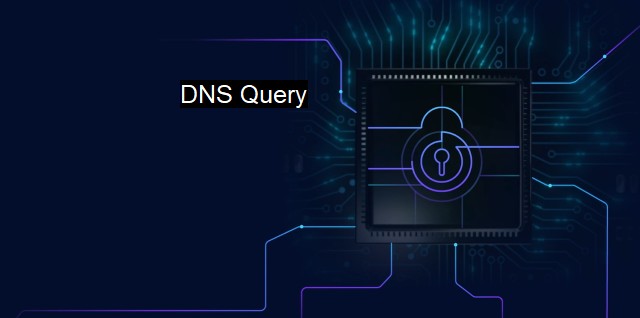What is DNS Query?
Exploring DNS Queries: Understanding How They Work and Their Importance in Cybersecurity and Antivirus Protection
DNS, an acronym for Domain Name System, is integral to the virtual world, acting as the internet's phonebook translating human-friendly website names like www.google.com into machine-readable IP addresses like 192.0.2.1, so computers can interact and communicate with each other. One essential element of the DNS is the DNS Query, a topic of growing importance in cybersecurity and antivirus discussions.The DNS query is a request sent from a device to a DNS server to resolve the domain name into the corresponding IP address. When you type a URL into your browser, your computer generates a DNS query, requesting the IP address linked to that domain name. This request is then sent to a DNS server, which utilizes a hierarchical and decentralized naming scheme to decode the domain name into an IP address.
Two main types of DNS queries are explored: recursive and iterative. In a recursive query, the DNS resolver seeks out DNS servers with a comprehensive response to the request. These servers might have the requested information cached, effectively simplifying and speeding up the process. if not, they would walk through and sort the DNS hierarchy, typically comprising root, top-level domain (TLD), and authoritative DNS servers, until the query is resolved. On the other hand, an iterative query functions on a referral basis. The requesting client effectively becomes a resolver, equipped with enough information to communicate with another DNS server further into the DNS hierarchy. If desired information is not readily available, the recursive resolver returns a list of nearby servers – often from the authority section in response – to whom it can refer this iterative query.
In the context of cybersecurity and antivirus systems, DNS queries provide a performance monitoring means and help in detecting illegal activities and advanced threats. On the one hand, DNS or network traffic can provide good situational awareness for managers. Analysis of DNS query logs at a granular level by cybersecurity suites makes it possible for organizations to monitor performance and server health, identify troublesome traffic patterns, detect denials of service (DoS/ DDoS), rapidly spot issues, and decide appropriate measures.
DNS protocol vulnerabilities can also be exploited for cybercrimes, including data exfiltration (information leakage), DNS tunneling (data encapsulation, command & control, botnets), or DNS-based Distributed Denial-of-Service (DDoS) attacks. Thus, carefully tracking DNS queries aids in detecting such abnormal behavior signaling spoofing, forgeries, or hijacking attempts in the network. Running DNS query logs through advanced threat detection and antivirus systems can spot known malicious domains, discover malware-infected sites, and also allow predictive insights into which IPs or domains are likely hazardous based on observed behaviors.
In modern times, harmful actors often use DNS queries to control malware installed on compromised systems, trick users, or exfiltrate data. Thus, encryption mechanisms like DNS over HTTPS (DoH) or DNS over TLS (DoT), further prevents eavesdropping, hijacking, DNS spoofing, or sniffing opportunities by cybercriminals by cryptographically safeguarding the DNS queries.
DNS queries underpin the fundamental mechanism that allows communication over the Internet. their misuse can lead to detrimental effects. In terms of cybersecurity and antivirus solutions, DNS query analysis becomes an assertive way to detect anomalies, mitigate risks, monitor performance, and ultimately maintain a safe internet sphere. Nonetheless, the ever-evolving cyber threat landscape necessitates robust mechanisms for interpreting DNS query data and tracking developments to stay ahead of adversaries.

DNS Query FAQs
What is a DNS query in cybersecurity?
A DNS query is a request made by a device to a Domain Name System (DNS) server to translate a domain name into an IP address. This is a crucial aspect of cybersecurity because many cyberattacks involve manipulating or redirecting DNS queries to carry out malicious activities.What is DNS hijacking and how does it work?
DNS hijacking is a type of cyberattack where an attacker intercepts DNS queries and redirects them to a fake website or server under their control. This allows the attacker to steal sensitive information such as login credentials or install malware on the victim's device. DNS hijacking works by exploiting vulnerabilities in the DNS system or by tricking users into visiting a malicious website.How can antivirus software help protect against DNS-based attacks?
Antivirus software can help protect against DNS-based attacks by monitoring network traffic and analyzing DNS queries for signs of suspicious activity. For example, if a DNS query is redirected to an unusual IP address or domain name, the antivirus software can alert the user and block the connection. Additionally, antivirus software can detect and remove malware that may be used to carry out DNS-based attacks.What are some best practices for securing DNS queries in a cybersecurity context?
Some best practices for securing DNS queries in a cybersecurity context include using reputable DNS servers, enabling DNSSEC to prevent DNS spoofing, implementing two-factor authentication for DNS servers, and regularly monitoring DNS logs for signs of suspicious activity. It's also a good idea to educate employees on how to recognize and avoid phishing attacks that may involve DNS manipulation.| | A | | | B | | | C | | | D | | | E | | | F | | | G | | | H | | | I | | | J | | | K | | | L | | | M | |
| | N | | | O | | | P | | | Q | | | R | | | S | | | T | | | U | | | V | | | W | | | X | | | Y | | | Z | |
| | 1 | | | 2 | | | 3 | | | 4 | | | 7 | | | 8 | | |||||||